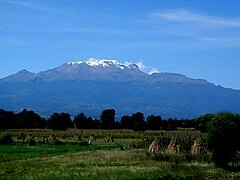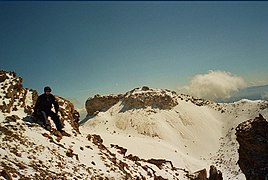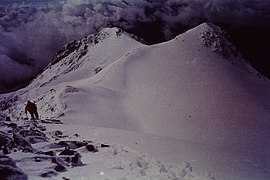Iztaccihuatl
| Iztaccíhuatl | |
|---|---|
Mexico prominent peaks 25th | |
| Coordinates | 19°10′44″N 98°38′30″W / 19.17889°N 98.64167°W[1] |
| Geography | |
| Location | Puebla, Mexico |
| Geology | |
| Volcanic arc/belt | Trans-Mexican Volcanic Belt |
| Last eruption | Holocene[1] |
| Climbing | |
| First ascent | 1889 by James de Salis |
| Easiest route | rock/snow climb |
Iztaccíhuatl or Ixtaccíhuatl (both forms also spelled without the accent) (Nahuatl pronunciation: Izta-Popo Zoquiapan National Park. It is the nation's third highest, after Pico de Orizaba at 5,636 m (18,491 ft), and Popocatépetl at 5,426 m (17,802 ft).
The name "Iztaccíhuatl" is
twin Popocatépetl, to which it is connected by the high altitude Paso de Cortés. Depending on atmospheric conditions Iztaccíhuatl is visible much of the year from Mexico City some 70 km (43 mi) to the northwest. The first recorded ascent was made in 1889, though archaeological evidence suggests the Mexica and previous cultures climbed it previously. It is the lowest peak containing permanent snow and glaciers
in Mexico.
Geology
The summit ridge of the massive 450 km3 (110 cu mi) volcano is a series of overlapping cones constructed along a NNW-SSE line to the south of the
glaciation, approximately 11,000 years ago. The most recent vents are at El Pecho and a depression at 5,100 m (16,700 ft) along the summit ridge midway between El Pecho and Los Pies.[1]
Legend of Popocatépetl and Iztaccíhuatl
Polanco district of Mexico City
In
Oaxaca, promising him Iztaccíhuatl as his wife when he returned (which Iztaccíhuatl's father presumed he would not). Iztaccíhuatl was falsely told that Popocatépetl had died in battle, and believing the news, she died of grief. When Popocatépetl returned to find his love dead, he took her body to a spot outside Tenochtitlan and knelt by her grave. The gods covered them with snow and changed them into mountains. Iztaccíhuatl's mountain is called "White Woman" (from Nahuatl iztāc "white" and cihuātl "woman") because it resembles a woman lying on her back, and is often covered with snow — the peak is sometimes nicknamed La Mujer Dormida, "The Sleeping Woman". Popocatépetl became an active volcano, raining fire on Earth in blind rage at the loss of his beloved.[3]
Elevation
Iztaccihuatl is usually listed at 5,286 m (17,343 ft), but
SRTM data and the Mexican national mapping survey assert that a range of 5,220 to 5,230 m (17,130 to 17,160 ft) is more accurate.[4][5] The Global Volcanism Program cites 5,230 m (17,160 ft).[1]
Gallery
-
Iztaccíhuatl from the Puebla side
-
Around the Knees (5,000 m (3.1 mi)) of Iztaccíhuatl
-
Forest fires on the slopes
-
View from the ridge of Mt. Izta towards Pico de Orizaba
-
Iztaccihuatl Ridge after the mountain shelter
See also
- List of mountain peaks of North America
- List of mountain peaks of Mexico
- List of volcanoes in Mexico
- List of Ultras of Mexico
- List of mountain peaks of Mexico
References
- ^ a b c d e f "Iztaccíhuatl". Global Volcanism Program. Smithsonian Institution. Retrieved 2010-06-22.
- ^ "Volcán Iztaccíhuatl". Summits of the World. peakbagger.com. Retrieved 30 June 2010.
- ^ "The Legend of Popocatépetl and Iztaccíhuatl". Online guide to Mexico.
- ^ "Elevaciones principales - Puebla" (in Spanish). Instituto Nacional de Estadística, Geografía e Informática. Archived from the original on 10 March 2012. Retrieved 17 March 2009.
- ^ "Lo más y lo menos del territorio de México - Montañas (más altas)" (in Spanish). Instituto Nacional de Estadística, Geografía e Informática. Archived from the original on 3 March 2012. Retrieved 22 February 2009.
External links
Descriptions
- Iztaccíhuatl - Volcano World
- Iztaccíhuatl - Ski Mountaineer
- "Iztaccihuatl". Peakware.com. Archived from the original on 2016-03-04.







